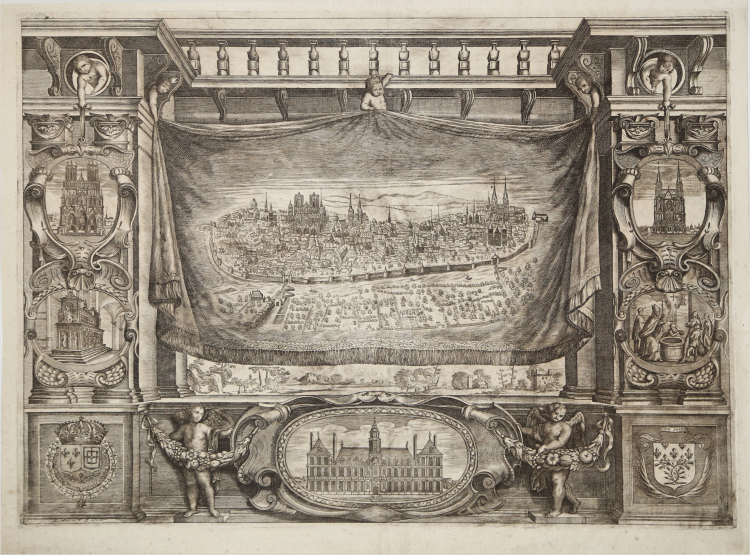



| Reference: | S20720 |
| Author | Edmé Moreau |
| Year: | 1630 ca. |
| Zone: | Reims |
| Measures: | 460 x 332 mm |


| Reference: | S20720 |
| Author | Edmé Moreau |
| Year: | 1630 ca. |
| Zone: | Reims |
| Measures: | 460 x 332 mm |
Very rare perspective view of the city of Reims, circa 1630, signed lower left E. Moreau fe & excudit.
Etching and engraving, printed on contemporary laid paper, with margins, in excellent condition.
Edmé Moreau was a French engraver, born in February 1596 in Châlons-en-Champagne and died in November 1648 in Reims. A nephew of Claude Chastillon, he practiced his craft in Reims from 1617 until his death, but was most active from 1620 to 1648. He would also have worked in Paris around 1601. His most important and best works were executed for the city of Reims, where he lived in the rue Saint-Étienne, then he worked with François Bernard at the Griffon d'Or, Nicolas Hécart at the Bible d'Or and collaborated with the engraver Nicolas Son. During World War I, his drawings and matrices, which constituted the city's important chalcography, were damaged by fire in 1917; then restored and reconstituted by local artist Abel Jamas.
His works are numerous; his burin was distinguished by finesse and lightness. At the time, the art of engraving was far from perfect, but Moreau seems a precursor of the great French school. He executed his most important and best works for the city of Reims, including three perspective plans. The first, derived from a drawing by his uncle Claude Chastillon, is dated 1622 and is dedicated to the citizens of Reims.
This third perspective, in chronological order although undated, relates to a few years later. He added a frame of vignettes - in a drapery decorated with bangs - representing the facades of the most prestigious buildings of the city, including the cathedral, the town hall, the tomb of Saint Remi, the portal of Saint-Nicaise, the baptism of Clovis and the arms of the city with the motto: "Dieu en soit garde".
This type of view - based on the maps of the great Dutch publishers Blaeu and Visscher - had become very fashionable at the time.
Work of great rarity.
Bibliografia
V Meyer, GBA 125 (1995), pp. 277-302
Edmé Moreau (Châlons-en-Champagne 1596 - Reims 1648)
|
died in November 1648 in Reims. A nephew of Claude Chastillon, he practiced his craft in Reims from 1617 until his death, but was most active from 1620 to 1648. He would also have worked in Paris around 1601. His most important and best works were executed for the city of Reims, where he lived in the rue Saint-Étienne, then he worked with François Bernard at the Griffon d'Or, Nicolas Hécart at the Bible d'Or and collaborated with the engraver Nicolas Son. During World War I, his drawings and matrices, which constituted the city's important chalcography, were damaged by fire in 1917; then restored and reconstituted by local artist Abel Jamas. His works are numerous; his burin was distinguished by finesse and lightness. At the time, the art of engraving was far from perfect, but Moreau seems a precursor of the great French school. He executed his most important and best works for the city of Reims, including three perspective plans.
|
Edmé Moreau (Châlons-en-Champagne 1596 - Reims 1648)
|
died in November 1648 in Reims. A nephew of Claude Chastillon, he practiced his craft in Reims from 1617 until his death, but was most active from 1620 to 1648. He would also have worked in Paris around 1601. His most important and best works were executed for the city of Reims, where he lived in the rue Saint-Étienne, then he worked with François Bernard at the Griffon d'Or, Nicolas Hécart at the Bible d'Or and collaborated with the engraver Nicolas Son. During World War I, his drawings and matrices, which constituted the city's important chalcography, were damaged by fire in 1917; then restored and reconstituted by local artist Abel Jamas. His works are numerous; his burin was distinguished by finesse and lightness. At the time, the art of engraving was far from perfect, but Moreau seems a precursor of the great French school. He executed his most important and best works for the city of Reims, including three perspective plans.
|